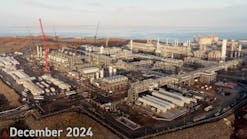A 60-day surge of an additional 1.5-2 bcfd of LNG is likely to hit the US market this summer, on top of its baseload LNG supply of 0.7-1 bcfd, said analysts at Pritchard Capital Partners LLC, New Orleans.
“US facilities can probably handle 5 bcfd of LNG, but if imports got much greater than 3 bcfd, domestic producers would likely fight back to defend market share, although exactly what realistic options they would have remains to be seen,” the analysts said.
“LNG traffic, all moving northbound through the Suez Canal, suggests that Asian markets are backing away from LNG purchases. A surge in LNG imports to the US in the late spring or early summer is highly likely,” the analysts said. “The question is how big will the surge be.” US natural gas prices as low as $3/Mcf “are a strong possibility this summer,” they said.
“One wild card is that South Korea and Japan could take advantage of low prices before the winter buying season and start to fill up sooner, reducing the supply coming here,” said Pritchard Capital Partners. “Three European facilities coming on line in 2009 will help absorb supply as the year progresses.” They expect a return to baseload supply levels around September.
Demand from Japan, South Korea, and Spain—the “Big Three” importers of LNG—has fallen this year because the global economic recession, said Pritchard Capital analysts. LNG storage in Spain is above 80% of capacity, and Japan and South Korea are looking to divert some cargoes.
Pritchard Capital analysts earlier reported, “Japan (world’s biggest user of LNG) is seeking to divert as many as six cargoes of the LNG from Indonesia over the course of this year as demand slows. Japan is very orderly on how they order LNG deliveries, so they’re simply planning ahead. Net effect is supplies shift westward to India and China initially; new supplies soak up demand, then continue to shift further westward, ultimately to the US (OGJ Online, Mar. 16, 2009).”
LNG producers are unlikely to reduce output for two main reasons, said Pritchard Capital after hosting a Mar. 18 conference call with Zach Allen, president of Pan EurAsian Enterprises Inc., a management advisory firm specializing in energy. “First, throttling back on production is said to be technically very challenging. Second, and more important, after stripping out and selling the natural gas liquids, producers such as Qatar have an effective cost on the gas that can be measured in pennies, so transportation, which typically runs $2/Mcf or less, is the main cost,” analysts said. “Therefore, LNG can be shipped here at prices below where we are today and still be profitable for the producers.”
African producers Nigeria and Equatorial Guinea would have to settle for prices of for $2.50-3/Mcf for May delivery in Asian markets, “making UK and US markets look better and better,” said Pritchard Capital analysts. “For the same reason, shipments from Trinidad will likely look toward the US.”
They said, “LNG will go to the UK as much as it can as storage there was drawn down by the Russia-Ukraine [gas] dispute earlier this year, but once that is absorbed the US becomes the destination of choice.”
During the conference call, the analysts said, “The point came up that if the market really believed that we were going to get the kind of LNG surge being bandied about, should not the forward curve [in the gas futures market] be in a backwardation rather than contango position? The main conclusion to that was we are in unchartered territory and to some extent will have to wait and see what happens as spring then summer approaches.”
